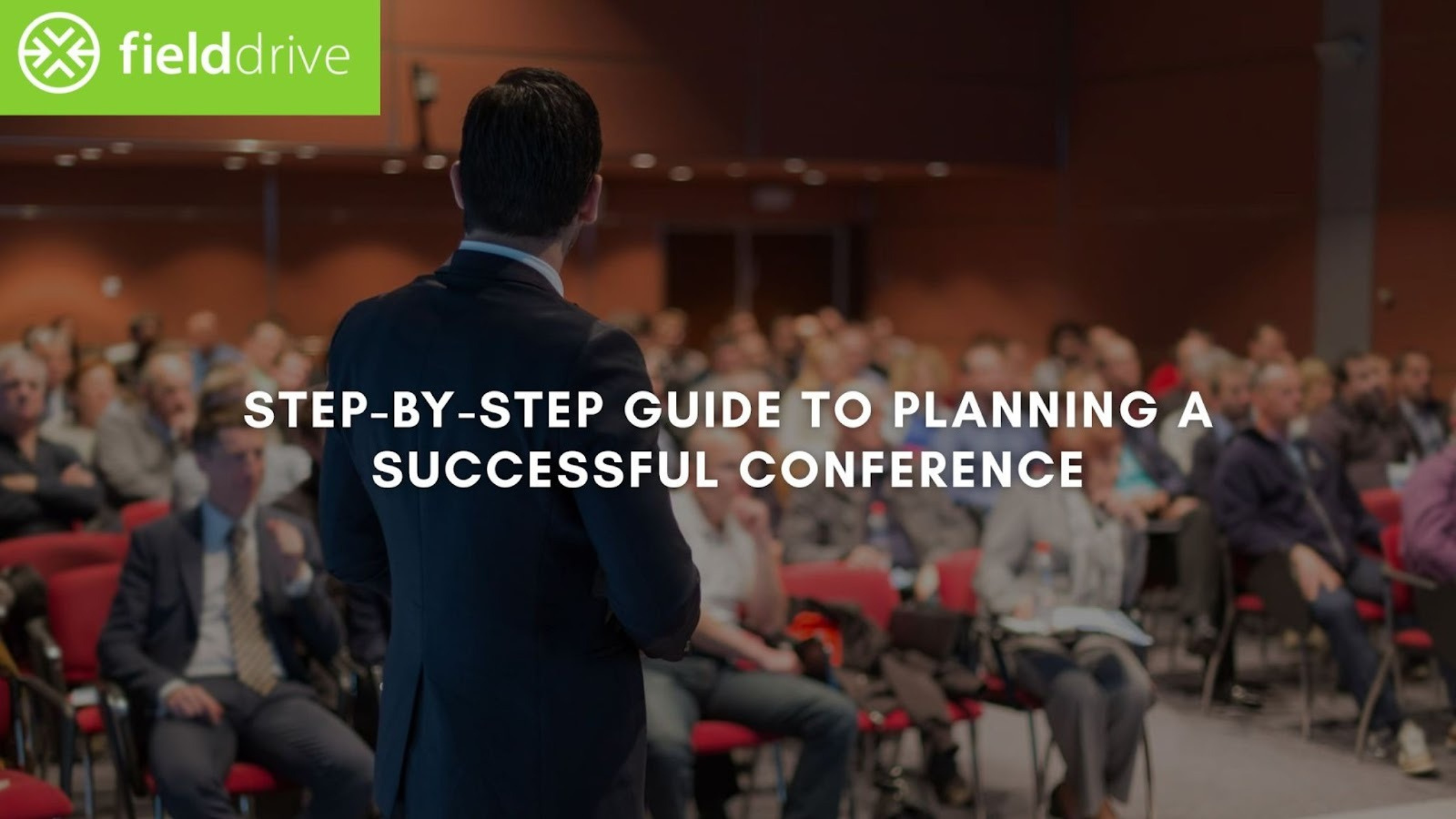Step-by-Step Guide to Planning a Successful Conference
Learn how to plan a successful conference with step-by-step strategies for smooth execution, high engagement, and lasting impact. Start planning now!

CONTENT
Conferences are where learning and connections come together in a way few other events can match. Studies show that 71% of attendees have met someone at a work event who later helped advance their career.
Being there in person makes a real difference. In-person meetings are nearly 30% more productive than virtual ones and help build trust and buy-in from colleagues and stakeholders.
But the results you get depend heavily on planning. Careful organisation shapes whether an event feels useful or just another meeting on the calendar. Thoughtful preparation helps every session, interaction, and moment count.
This article explores how to plan a successful conference. It looks at why preparation matters and how you can create a meaningful and memorable experience for attendees.
Key Highlights:
- Conferences succeed when planning aligns objectives, audience needs, and resources well in advance.
- Clear budgeting and early venue selection prevent logistical challenges and enable smooth operations.
- Structured team roles and program design improve attendee engagement and session flow.
- Marketing, promotion, and personalized messaging boost registration and audience participation.
- Post-event follow-up, including feedback and content sharing, strengthens future events and relationships.
Why Careful Planning Defines Conference Success
When a conference is rushed or left to chance, the impact can be disappointing. Sessions feel disconnected, attendees drift in and out, and resources get spent without meaningful results. Planning ahead creates clarity and keeps everyone aligned.
Here’s why structured preparation matters:
- Better engagement: Attendees notice when sessions are thoughtfully organized. They stay focused and participate actively, increasing networking and knowledge sharing.
- Higher turnout: Announcing events with enough lead time and clear messaging helps people commit. Early engagement drives attendance and excitement.
- Efficient execution: Coordinated logistics reduce last-minute chaos. Teams know their roles, timelines, and contingencies, so the day runs smoothly.
- Stronger returns: Properly planned conferences make better use of budgets. Each investment contributes directly to participant satisfaction and measurable outcomes.
Also Read: How to Create an Event Timeline for Flawless Execution (with Template)
Starting months in advance gives time to coordinate venues, tech solutions, programs, and communications without stress. Thoughtful preparation sets the stage for an event where everything flows naturally and achieves its goals.

Step-by-Step Guide to Planning Your Next Conference
Once you know your goals and who will attend, it’s time to turn those ideas into action. Conferences have many moving parts, and planning each piece step by step helps everything come together smoothly.
Here’s a roadmap to take your conference from concept to completion:
1. Define the Foundation
Getting the basics right first saves time later. Setting objectives guides every choice you make and keeps the event focused. Consider who will attend and what they hope to achieve.
Select a theme that aligns with both your objectives and the needs of your target audience. This approach sets the tone and ensures consistency throughout the event.
Here’s what to focus on:
- Objectives: Decide what success looks like for learning, networking, or professional growth.
- Target audience: Identify their expectations, interests, and level of expertise.
- Theme: Pick a unifying concept that makes sessions and materials cohesive.
2. Create a Realistic Budget
A clear budget gives structure to your planning. When you know which costs are fixed and which can change, it’s easier to make smart decisions. Including a contingency ensures surprises don’t disrupt the conference. Here’s how to handle it:
- Fixed costs: Venue, speakers, tech setup, core staffing.
- Variable costs: Materials, AV adjustments, and additional equipment.
- Contingency buffer: Extra funds to cover unforeseen expenses without stress.
3. Secure Venue and Date
Your venue and timing shape the entire experience. Accessibility and capacity are crucial for ensuring attendance and comfort. Facilities like breakout rooms and hybrid options make the event flexible and inclusive. Planning these early keeps logistics simple. The main details to get right include:
- Capacity: Enough space for attendees and sessions.
- Accessibility: Easy transportation and accommodations are available for participants.
- Facilities: AV support, hybrid streaming, and breakout rooms.
4. Build the Core Team and Roles
Your team is the backbone of the conference. Clear roles prevent confusion and ensure every task is handled efficiently. When everyone knows their responsibilities, the event flows naturally. Key roles include:
- Manager: Oversees the event and coordinates teams.
- Logistics: Handles operations and day-of execution.
- Marketing: Promotes the event and drives engagement.
- Tech: Supports registration, check-ins, and AV.
- Volunteers: Assist attendees and smooth operations.
Also Read: Top 10 Event Planning Industry Trends to Watch for in 2025
5. Design the Program and Book Speakers
The agenda determines how engaged participants will be. A balanced mix of keynotes, panels, and workshops helps maintain energy levels. Selecting the right speakers adds credibility and aligns with the theme. Pay attention to:
- Agenda mix: Balance learning, discussion, and interactive sessions.
- Pacing: Keep sessions engaging without overloading attendees.
- Speaker relevance: Ensure expertise matches audience expectations.
6. Technology and Registration Setup
Efficient tech makes the event feel professional and seamless. Registration software and check-in solutions reduce delays and improve satisfaction. When you track attendance and engagement in real-time, decisions can be made more quickly. Key aspects include:
- Registration software: Manage tickets and attendee information.
- Ticketing tiers: Offer options for different audience segments.
- Check-in: Smooth entry with minimal waiting.

7. Secure Sponsors and Partnerships
Sponsors bring both credibility and valuable resources to your conference. When you can show clear value, it encourages collaboration and helps build lasting relationships that continue beyond the event itself. Here are the areas to keep in mind:
- Sponsor value: Visibility, networking, or content integration.
- Pitch approach: Highlight benefits specific to each partner.
- Partnership examples: Align with relevant brands or organizations.
8. Marketing and Promotion
Promotion ensures the right people hear about your event and commit to attending. Early engagement builds excitement and sets expectations. Personalization also plays a key role.
Studies show that 71% of consumers expect companies to deliver personalized interactions, and 76% feel frustrated when this expectation is not met. Applying that insight to your event promotion means each message should feel relevant to the audience. Here’s how you can put that into practice:
- Channels: Social media, email campaigns, and event website.
- Early-bird strategies: Incentives to secure early registrations.
- Consistent messaging: Clear details about purpose and benefits.
9. Logistics and On-the-Day Execution
Every operational detail has a direct impact on how attendees experience the event. Coordinated efforts help prevent delays, confusion, and unnecessary stress for both participants and the team. These elements help ensure everything runs smoothly on the day:
- Catering: Meals and refreshments are planned for timing and preferences.
- AV setup: Screens, sound, and presentations work seamlessly.
- Signage: Clear directions guide participants effortlessly.
- Staff coordination: Teams are aware of their responsibilities and communication channels.
10. Post-Conference Follow-Up
Closing the loop after the event reinforces relationships and helps gather insights that improve future conferences. Feedback and sharing of resources increase overall satisfaction and encourage ongoing engagement. Pay attention to these areas to close the event successfully:
- Feedback collection: Surveys to measure experience and gather suggestions.
- Thank-yous: Express appreciation to attendees, speakers, and partners.
- Resource sharing: Provide slides, recordings, or summaries.
- KPI review: Assess attendance, engagement, and outcomes to improve next events.
Also Read: The Best Event Planning Checklist to Use in 2025
These steps cover the essentials, but every conference can still face hurdles. Recognizing common mistakes enables you to address them before they impact attendees.
5 Mistakes That Can Slow Down Your Conference
Even experienced organisers can encounter issues that quietly impact a conference. Knowing what can go wrong allows you to take action before it impacts attendees. Here are key mistakes to watch for:
1. Back-to-Back Sessions
Fitting too many sessions into a schedule leaves little room for reflection or networking. Attendees can feel rushed and distracted, missing important takeaways. A balanced agenda helps maintain consistent energy and focus.
2. Unclear Communication
When instructions or updates are confusing, attendees struggle to follow along. Missing or unclear messaging can cause frustration and disengagement. Clear communication ensures participants know what to expect and how to navigate the event.
3. Technology Breakdowns
Problems with registration systems, presentation screens, or audio setups disrupt sessions and create stress. Reliable tech solutions prevent interruptions and maintain a smooth experience.
4. No Backup Plan
Last-minute cancellations or equipment failure can throw off timing. Without alternatives, small problems grow, affecting flow and participant satisfaction.
5. Ignoring Participant Experience
Focusing solely on logistics or content without considering comfort reduces the event’s impact. Thoughtful touches, such as clear signage, smooth check-ins, and accessible spaces, keep attendees engaged and happy.

When you can anticipate what might go wrong, it’s easier to fix it before it becomes a problem. fielddrive can help you handle these challenges and keep your conference on track. Let’s see how.
fielddrive Solutions to Common Conference Challenges
After looking at the mistakes that often weaken a conference, it’s clear that the right support can make a difference. fielddrive helps you avoid long queues with instant facial recognition check-ins, and its on-site badge printing saves hours of work before the doors even open.
Real-time attendee tracking makes it easier to manage crowd movement, while secure access control ensures only the right people enter key sessions.
With data analytics available as soon as the event ends, you’ll have the insights to make the next conference stronger from day one.
Operating in 50+ countries with a history of firsts in event tech, fielddrive meets the needs of conferences focused on efficiency and attendee satisfaction.
Conclusion
Planning a conference well sets the stage for meaningful connections and memorable experiences. Each careful decision, from team roles to program design, adds up to smoother execution and stronger attendee engagement.
On the day, fielddrive supports your team by keeping operations coordinated and giving clear visibility into attendee flow, so you can focus on the experience itself. With thoughtful preparation and the right support, your conference can run smoothly and leave a lasting impression.

FAQs
1. How can hybrid conferences be optimized for both in-person and virtual attendees?
Hybrid conferences require thoughtful tech integration and engagement strategies. Interactive polls, live Q&A, and session recordings ensure virtual attendees feel included and can interact alongside in-person participants.
2. What are some creative ways to keep attendees engaged between sessions?
Engagement between sessions can be maintained through structured yet interactive activities. Options include mini workshops focused on skill-building, themed discussion corners, live polls or quizzes related to sessions, and networking challenges that encourage participants to connect with new people.
3. How can sustainability be incorporated into conference planning?
Use digital materials instead of printed programs, select eco-friendly catering, and choose venues with green certifications. Encouraging recycling and reducing single-use plastics also helps minimize environmental impact.
4. What strategies help attract high-profile speakers or industry experts?
Offer clear value propositions such as visibility, networking opportunities, or unique session formats. Personalized outreach and highlighting past successful conferences can also increase interest.
5. How can post-event content be repurposed effectively?
Post-event content should be strategically reused to extend impact. Recordings of sessions can be converted into shorter clips for use on social media or as educational resources. Slides and key takeaways can be bundled into guides or newsletters.
Want to learn how fielddrive can help you elevate your events?
Book a call with our experts today



.png)
.svg)
.svg)
.svg)

.svg)